This was published 6 years ago
Silo Art Trail, Wimmera, Victoria: Artists turn grain silos into Australia's biggest permanent outdoor gallery
By Tim Richards
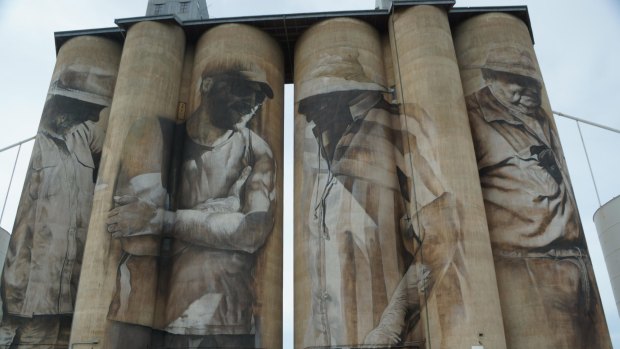
Mural-adorned wheat silos in Brim.Credit: Alamy
"She was OK about it, but he was really embarrassed," says our guide, Justin.
We're standing on a side street in the town of Rupanyup, in the Wimmera region of western Victoria, gazing at two galvanised steel grain silos.
On each of these is a black-and-white painting of a young person in sporting gear. Ebony, on the left, is dressed for netball; Jordan, on the right, for football. Their youthful faces loom from these decommissioned silos courtesy of Russian artist Julia Volchkova, who created the aerosol paint portraits after spending months in the community.
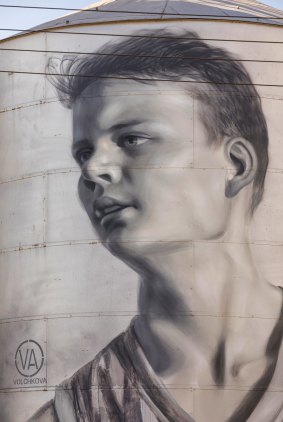
Silo art by Julia Volchkova.Credit: Nicole Reed
Given the town's population is only 536, the kids could expect a bit of good-natured teasing from their mates. But their participation has helped revive the dwindling settlements of a region that's rarely attracted tourists.
That all changed in 2016, when artist Guido van Helten completed his spectacular rendition of four local farmers on the concrete silos of Brim, to Rupanyup's north.
The massive mural was the initiative of a community group trying to save their town from extinction, and it succeeded beyond their wildest dreams. The art gained widespread press coverage, and travellers headed to Brim to take it in.
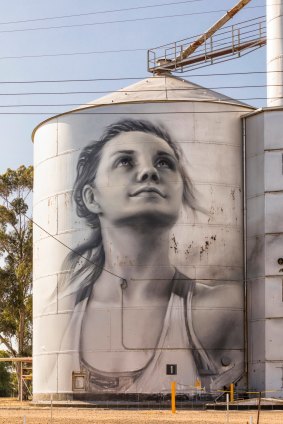
Silo art by Julia Volchkova.Credit: Nicole Reed
Thus the Silo Art Trail was born. So far six sets of 1930s silos have been painted, on a route stretching 200 kilometres from Rupanyup to Patchewollock.
Lacking a car, my wife Narrelle and I are taking the Silo Art Tour run by Grampians Wine Tours, and are joined in the minibus by a lively group from Phillip Island.
On the way into Rupanyup, I noticed a slogan on the town's welcome sign: "A Town With Pulse". Not only is it alive and kicking, the district is a major producer of pulses such as lentils and chickpeas.
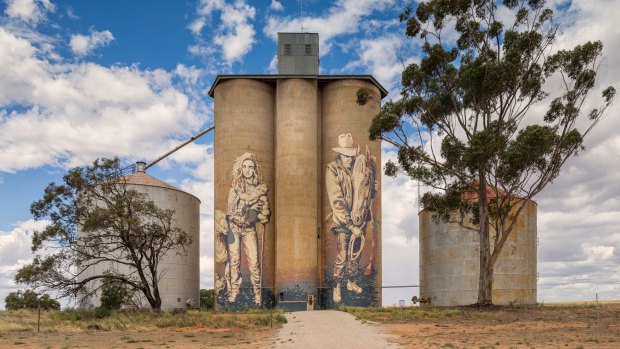
Silo art by Kaff-eine.Credit: Nicole Reed
In the town we have a sample of the latter. At Rupanyup Living, a food and homewares store inside an old grocer's shop, local farmer Claire Morgan dishes up chocolate brownies made with chickpea flour. They're delicious, smooth and moist, and flavoured with vanilla, peppermint or chilli.
Claire confirms that the silo art has made a big difference to the region. "I see people in here from all over the world," she says.
Back in the minibus, we head north through Minyip (where the Flying Doctors TV series was filmed), past low flat countryside covered with the green shoots of wheat still a few months from harvest.
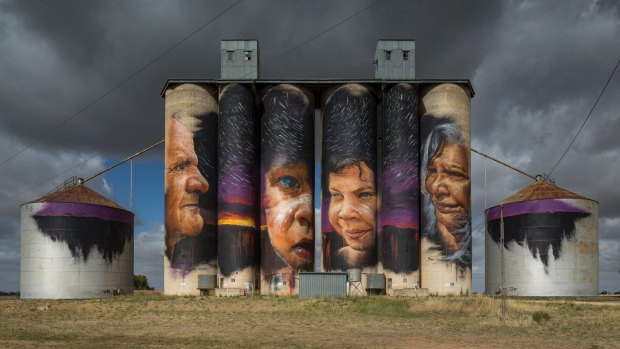
Silo art by Adnate. Credit: Nicole Reed
As we approach the second set of silos at Sheep Hills, Justin tells us that the artist, Adnate, wanted to start a conversation about the local Aboriginal people who were displaced by farming.
The result is a spectacular work, covering six tall concrete silos anchored by two low galvanised ones.
Four of the silos feature the faces of local Indigenous people: Wergaia elder Ron Marks, Wotjobaluk elder Regina Hood, and two young children. Behind them is a striking night sky after sunset, a rich purple and black field streaked with stars. According to the signage at the site, the work signifies the exchange of knowledge and traditions through generations.
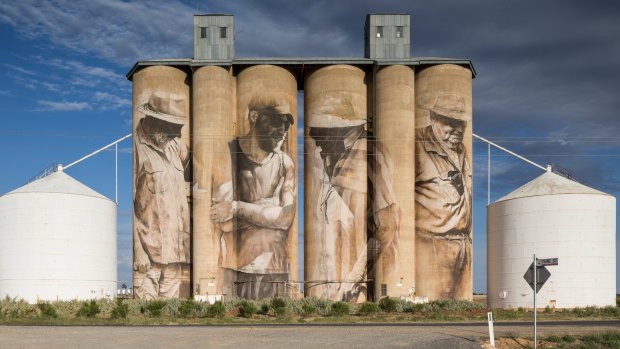
Silo art by Guido van Helten in Brim.Credit: Visit Victoria
I'd expected to enjoy the art, but only now realise how important is the setting. The people depicted at each site are from the area, the silos from its farming heritage, and they're set against the broad green landscape which has been here forever.
Add in the chilly breeze, and it's a completely different experience from standing within the tame walls of a gallery. These huge murals are worthy of a grand setting, and in the plains of the Wimmera they have it.
I flick through the guestbook that sits within a sheltered box, and am moved by how visitors react to the art. The word "amazing" appears often, along with longer comments reflecting on its beauty.
As I chat with one of the Phillip Islanders, he expresses admiration for the silo artists, battling high winds and fluctuating temperatures while working aboard cherry pickers. It turns out my fellow tour member once worked for a paint company and still paints houses, so he knows what he's talking about.
Lunch is at a pub in what passes for the big smoke, the town of Warracknabeal (population 2438 – there really aren't a lot of people in this part of Victoria).
On the way in Justin drives down a side street, points to a tiny house with a tiled roof and says: "Nick Cave lived here as a kid." Then, passing a roundabout decorated with statues of sheep: "You haven't had a night out in Warracknabeal, until you've ridden one of those home." It's clearly more of a party town than its quiet streets would suggest.
After dining we pass a sprawling bulk storage facility, in which harvested wheat is piled under a huge blue cover within a low concrete wall. It's the storage method which replaced the silos, and is thoroughly unromantic.
The wheat industry's loss is our gain, however, and our third art stop of the day is at the famous silos of Brim. When van Helten painted this at the end of 2015 there were issues, says our guide: "He had a fair few dramas with high winds, dust, heat."
The result is remarkable. The four figures of local farmers were rendered with aerosol paints in a translucent style, and seem to grow out of the curving concrete surfaces. They're infused with life, each figure bearing an enigmatic expression.
While we're parked by the silos, several other visitors arrive in cars and motorhomes. Sadly, this influx has come too late to save the pub in the adjacent town of 171 people. There's an element of "chicken and egg" to the impact of the trail – if people visit, the locals would like them to spend money in the towns; but is it worth opening new businesses in anticipation of visitors?
I muse on the vagaries of tourism as we head to our final work for the day, at Rosebery. Each of its two silos bears a single figure: a young female farmer to the left, and a male farmer with his horse on the right. The artist, Kaff-eine, was aiming to depict the past, present and future of farming. Painted mostly using rollers, the monochrome figures edged in red seem strong and enduring.
There are two more silos on the trail, at Lascelles and Patchewollock, but the afternoon is wearing away so we turn back to the south.
However, Justin has one more surprise for us. In a side street at Rupanyup, Melbourne artist Goodie left behind her own work after assisting Volchkova. On the former shire offices she painted a fireman, shouldering a hose which playfully extends around the corner of the building.
Art is everywhere in the Wimmera, it seems, between the tiny towns and the endless fields of wheat.
Rupanyup is 294 km from Melbourne, about 3.5 hours' drive via the Western Highway. From there, the Silo Art Trail extends over 200 km, a two-hour drive.
TOUR
Grampians Wine Tours offers its Silo Art Tour on Thursdays, Fridays and Sundays, with pickups from Halls Gap, Pomonal, Stawell and Horsham. Fee $99 including morning tea and lunch, see www.grampianswinetours.com.au/silo-art-tour
Tim Richards travelled courtesy of Visit Victoria and Grampians Wine Tours.
Sign up for the Traveller Deals newsletter
Get exclusive travel deals delivered straight to your inbox. Sign up now.